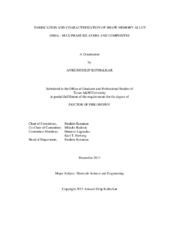| dc.description.abstract | With the rapid growth of the transportation industry (automotive and aerospace), the demands for the control of noise and enhancing the stability of structures, through the development of high damping materials are continually increasing. In the last two decades, increasing attention is being given to develop high damping materials for various applications. The aim of this study is to develop high damping material by combining these two unique material systems, a NiTi (SMA) with a Ti3SiC2 (MAX phase) which are individually excellent materials for damping applications. Another goal here is to investigate whether large recoverable shape change in SMAs during thermo-mechanical cycling can generate residual stresses and defects that could further enhance damping capability of the novel SMA-MAX phase composites.
In this study, NiTi-Ti3SiC2 composites are processed using spark plasma sintering (SPS) technique and microstructurally characterized using scanning electron microscopy (SEM) to study the distribution of NiTi, Ti3SiC2 and remnant porosity in the composite. The highest energy dissipation is observed for the thermo-mechanically cycled (TC) composite followed by the as-sintered (AS) composite, pure NiTi and pure Ti3SiC2 when compared at the same applied stress levels. Both the AS and TC composites exhibited higher damping up to 200 MPa stress than any of the metal – MAX phase composites reported in the literature to date. Interfaces play a crucial role in determining the overall properties and performance of the composites. Bulk components of NiTi (SMA) and Ti3SiC2 (MAX phase) are successfully joined using pressure assisted diffusion bonding.
Interfaces thus formed are micro-structurally characterized where the interfacial structure consists of NiTi / Ti2Ni / Ti5Si3 / NiTiSi / Ti3SiC2. Nano-indentation showed that the elastic moduli of the phases in the interface are close to that of Ti3SiC2 while their hardness is higher than that of both Ti3SiC2 and NiTi.
Four-point bend delamination tests are used to study the fracture behavior of the NiTi-Ti3SiC2 interface under mixed mode loading configuration for bilayer specimens. NiTi starts to deform plastically in the region between the inner loading points prior to crack propagation suggesting the formation of strong, tough interface. This is contrary to most literature studies wherein crack propagation occurs prior to onset of plastic deformation in the metallic phase, because of the weak interface. Thus, this study demonstrates the interplay between the interfacial and yield strength of the metallic phase in determining interfacial fracture behavior. Fracture occurs along the interface between Ti3SiC2 and NiTiSi phase, occasionally inside the Ti3SiC2 phase and also in the different phases in the reaction layer. Formation of strong interface enables efficient load transfer between SMA and MAX phase leading to the observation of excellent damping in composites. In conclusion, this study demonstrates the potential of novel SMA-MAX phase composites for high damping applications. | en |


